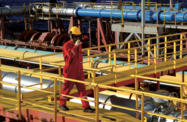A continued scaling back on energy, feedstock and utilities subsidies is likely to impact earnings in Saudi Arabia’s industrial sector, potentially reducing its long-held competitive edge.
Price increases announced in late December on power, water and a range of other inputs – including oil, natural gas and ethane used as feedstock by the petrochemicals industry – are expected to raise operating costs by as much as 8% for some of Saudi Arabia’s largest industrial operators. Similar moves were announced by Bahrain and Oman in mid-January.
While higher fuel prices can be expected to lead to higher transport, power-generation and utilities charges, rising supply costs are also likely to have a direct impact on the petrochemicals industry, where low-cost inputs have translated into more cost-competitive goods.
In a statement issued late last year, the Saudi Arabia Basic Industries Corporation (SABIC), one of the world’s largest petrochemical producers, estimated its production costs would increase by 5% this year, while Saudi Arabia Fertilisers expects an 8% jump and Yanbu National Petrochemical predicts a 6.5% rise.
Margin squeeze
The subsidy cuts are part of a wider move aimed at narrowing Saudi Arabia’s budget deficit, which reached an estimated SR367bn ($97.8bn) last year, equivalent to roughly 16% of GDP. This year’s budget seeks to narrow the gap to SR326bn ($86.9bn), though any further declines in oil prices could make this more difficult to achieve.
According to an IMF report issued last month, the Saudi economy will expand by 1.2% in 2016, its slowest rate of growth since 2002 and less than half the 3.4% posted in 2015.
Higher input costs, combined with more volatile global markets, have driven the Kingdom’s industrial firms to pare back operating expenses. After reporting a 29% year-on-year drop in fourth-quarter profits, SABIC announced cost-cutting measures and plans to improve efficiency at its plants.
Efficiency gains
For its part, the International Energy Agency (IEA) expects longer-term gains from the move, as the scaling back of subsidies makes Saudi industry leaner and even more competitive.
“The net long-term impact for Saudi Arabia is likely to be positive, as government balances improve and resource allocations become less distorted,” the IEA said in a January report.
According to Masood Ahmed, director of the Middle East and Central Asia department of the IMF, Saudi Arabia’s fiscal tightening is expected to have a “dampening effect on non-oil growth”, though these reductions could ultimately strengthen the economy in the medium-to-longer term.
“This consolidation, along with the other measures that have been signalled on privatisation and restructuring of the economy, should also lay the basis for stronger growth,” Ahmed said.
Advantages remain
Despite higher feedstock costs and increased competition, both within the region and from Chinese producers, Saudi petrochemical firms may still hold a competitive advantage.
According to JP Morgan, “Saudi [petrochemicals] remain at the lower end of the cost curve and competitive advantage remains intact.”
Indeed, despite subsidy reforms, input costs for Saudi industry players remain below international market rates. According to data from the IEA, petrol prices rose from SR0.45 ($0.12) to SR0.75 ($0.20) per litre for 91-octane fuel, and from SR0.60 ($0.16) to SR0.90 ($0.24) per litre for 95-octane grade as of January 11.
The agency predicted that prices for transport diesel, industrial diesel and kerosene would rise by 79%, 55% and 12%, respectively, as part of the Kingdom’s five-year subsidy rationalisation plan.
While subsidy reforms have been softened somewhat by the low price of crude oil, further cuts could bring raw material and fuel prices more in line with international markets. In the meantime, Saudi industry will be looking to adapt to the latest changes and hone its competitive edge.
Oxford Business Group is now on Instagram. Follow us here for news and stunning imagery from the more than 30 markets we cover.

